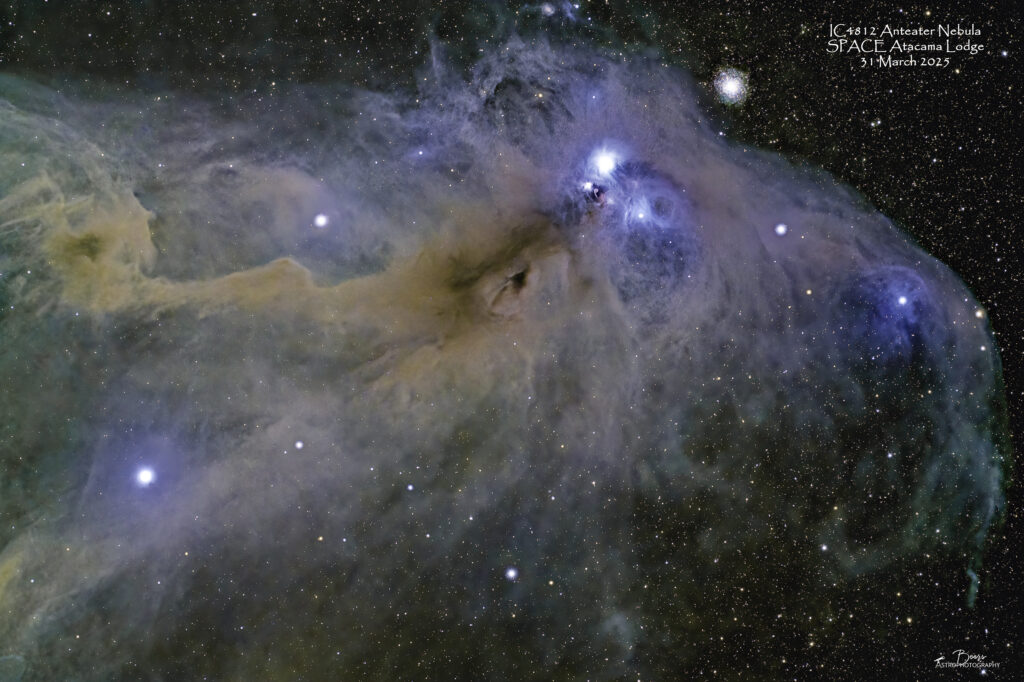
Fun facts
The rather bizarre looking complex of dust and gas combines the steely blue reflection nebulae of IC 4812 and NGC 6726/27 which form the bulging eye with the densest part of Bernes 157 forming the body of the Anteater. From the body faint legs are spread out either side. The Anteater appears to be eyeing up nearby NGC6723, a globular in neighboring Sagittarius. The irregular variable star R Coronae Australis is immersed in NGC 6729, the smallest of the three reflection nebulae.
This complex is 420 light years away, while the Anteater may not be as close to its prey as it would like, NGC 6723 is a further 28,000 light years away again!
Location: RA: 12h 01m 54s / DEC: -18° 51’ 54” (Chadwick/Cooper book)
Location: RA: 19h 01m 37.84s / DEC: -36° 51’ 19.1” (Stellarium)
Distance: 420 light years
Apparent dimensions: 2.7° x 2.1° (Chadwick/Cooper book field size)
Constellation: Coronal Australis / Sagittarius
Other Designations: The Anteater Nebula, NGC 6726/27, Ced 165b, NGC 6723, NGC 6729, IC 4812, Bernes 157
{ From: Imaging the Southern Sky; by Stephen Chadwick & Ian Cooper; pp. 224-226 }
Capture & Processing Notes
The Anteater was the second target of the night and the last of this trip. I got started on the capture at 02:56CDT after the Eta Carina Nebula mosaic capture. Recycled the connection to power (unplugged/replugged the autoguider cable), turned off PHD2, reconnected, and started the sequence. Everything went well. Came out at 0655 to terminate the sequence at the end of astronomical twilight. Marked the last subframe, that started capture at 06:51CDT, bad for too much light.
Sequence Plan (1Apr2025): Gain 158, Offset 30, Temp 0°C; 43x5min. Captured 1Apr2025, 0303CDT – 0656CDT (last frame marked bad, so image stack contains 42x5min). Total exposure time: 3:30hrs.
Processing summary: Captured in SGP, stacked in APP (Adaptive Airy Disc), star removal with Starnet++, processing with LR/PS
Equipment
Equipment: All equipment controlled by HP Probook (DSO-CTRL1) running Sequence Generator Pro v4.4.1.1441.
- Imaging (ASI2400-SC): ZWO ASI2400MC imaging camera; (Southern Cross) Askar FRA600 108mm f/5.6 Quintuplet Petzval Flat-Field Astrograph
- Mount: Rainbow Astro RST-135E (controlled by iHubo ASCOM driver)
- Polar alignment: QHYCCD camera (controlled by Polemaster for polar alignment)
- Autoguiding: Orion 60mm Multi-Use Guide Scope with Orion StarShoot AutoGuider Pro Mono Astrophotography Camera (controlled by PHD2)
- Autofocuser: ZWO EAF Electronic Automatic Focuser (EAF-5V-STD)
Summary
Captured: 1Apr2025, 0303CDT – 0656CDT. 42x5min. Total exposure time: 3:30hrs.
Shooting location: San Pedro de Atacama Celestial Explorations (SPACE) Atacama Lodge
Equipment: Southern Cross on Rainbow Astro RST-135E
Processing summary: Captured in SGP, stacked in APP (Adaptive Airy Disc), star removal with Starnet++, processing with LR/PS
